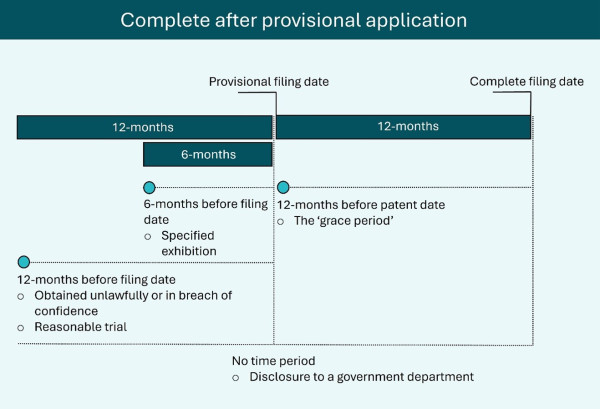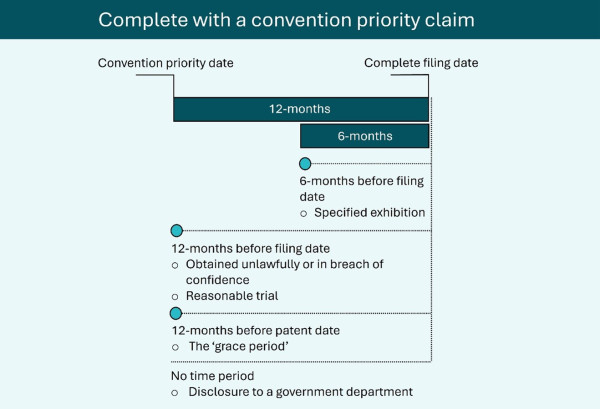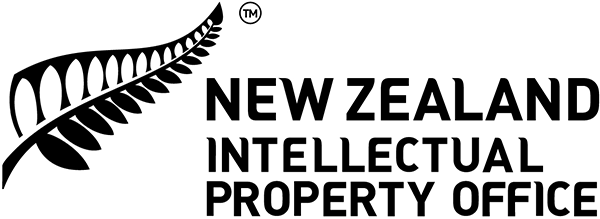In this practice guideline
Section 9: Disclosure to be disregarded in certain circumstances
1) For the purposes of section 8, the disclosure of matter constituting an invention must be disregarded if one or more of the following applies:
(a) that disclosure occurred during the 1-year period immediately preceding the filing date of the patent application and the disclosure was due to, or made in consequence of, the matter having been obtained unlawfully or in breach of confidence by a person from—
(i) the inventor; or
(ii) any other person to whom the matter was made available in confidence by the inventor; or
(iii) any other person who obtained it from the inventor because the person or the inventor believed that the person was entitled to obtain it; or
(iv) any other person to whom the matter was made available in confidence by any person referred to in subparagraphs (i) to (iii) or in this subparagraph; or
(v) any other person who obtained it from any person mentioned in subparagraphs (i) to (iv) because the person or the person from whom the person obtained it believed that the person was entitled to obtain it:
(b) that disclosure occurred during the 1-year period immediately preceding the filing date of the patent application and the disclosure was made in breach of confidence by a person who obtained the matter in confidence from the inventor or from any other person to whom it was made available by, or who obtained it from, the inventor:
(c) that disclosure was due to the communication of the matter to a government department or to any person authorised by a government department to investigate the invention or its merits, or to anything done, in consequence of that communication, for the purpose of the investigation:
(d) that disclosure occurred during the 6-month period immediately preceding the filing date of the patent application and that disclosure was due to, or made in consequence of,—
(i) the display of the invention with the consent of the inventor at a specified exhibition; or
(ii) the use of the invention with the consent of the inventor for the purposes of a specified exhibition in the place where it is held; or
(iii) the publication of any description of the invention in consequence of its display or use at a specified exhibition as referred to in subparagraph (i) or (ii); or
(iv) the use of the invention, after it has been displayed or used at a specified exhibition as referred to in subparagraphs (i) and (ii) and during the period of the exhibition, by any person without the consent of the inventor:
(e) that disclosure was due to, or made in consequence of, the invention being publicly worked, at any time during the 1-year period immediately preceding the filing date of the patent application, by any of the following persons if the working was effected for the purpose of reasonable trial only and if it was reasonably necessary, having regard to the nature of the invention, that the working for that purpose should be effected in public:
(i) the patentee or nominated person:
(ii) any person from whom the patentee or nominated person derives title:
(iii) any person with the consent of the patentee or nominated person:
(iv) any person with the consent of any person from whom the patentee or nominated person derives title.
(f) that disclosure occurred during the 1-year period immediately preceding the patent date and the disclosure was made by any of the following persons:
(i) the patentee or nominated person:
(ii) any person from whom the patentee or nominated person derives title:
(iii) any person with the consent of the patentee or nominated person:
(iv) any person with the consent of any person from whom the patentee or nominated person derives title.
2) For the purposes of this section,—
inventor, in relation to an invention,—
(a) means the actual deviser of the invention; and
(b) includes any owner of the invention at the relevant time.
specified exhibition means an exhibition (whether held in New Zealand or elsewhere) that is declared to be an international or industrial exhibition by the Commissioner in a notice that is publicly notified.
Introduction
1. This guideline outlines the circumstances in which certain disclosures may be disregarded as prior art, and how applicants can request to have such disclosures disregarded.
General information about section 9
2. Section 9 sets out the specific circumstances where disclosures can be disregarded from the prior art base. This applies to the prior art base under both section 8(1) and 8(2).
3. The term ‘disclosure’ in section 9 refers to disclosure to the public. This includes any form of publication or any other means of disclosure to the public. The mere filing of a patent application at IPONZ or an overseas office is not a disclosure to the public. However, any subsequent publication of such a patent application would be a disclosure to the public.
4. Sections 9(1)(a) and 9(1)(b) are concerned with the way the information about the invention was obtained and how it was disclosed to the public. As the circumstances relating to these grounds will not typically be readily available, the applicant will need to make formal submissions to establish these grounds.
5. Sections 9(1)(c)-(f) are concerned with special circumstances where the invention may have been disclosed. These grounds can be considered by an examiner in view of the information that is readily available.
6. If a disclosure clearly falls within one of the grounds, it can be disregarded without requiring a formal request. If the examiner is in doubt about the criteria, a novelty and/or inventive step objection should be raised. The applicant can then provide further information in response to the objection.
Definition of the relevant time period
7. Section 9 refers to two different time periods under the different grounds:
- Sections 9(1)(a), (b), (d) and (e) refer to the period immediately preceding the ‘filing date of the patent application’.
- Section 9(1)(f) refers to the period immediately preceding the ‘patent date’.
8. The ‘filing date of the patent application’ means the date on which the patent application was filed (or treated as having been filed) under the Patents Act 2013. In practice, this should be the ‘filing date’ as listed on the bibliography page of the application being considered.
9. The ‘patent date’ is not legally assigned under section 103 until the patent is granted. During examination of the application, the meaning of patent date is taken to be the filing date of the relevant specification (or a different date if allowed by the regulations). In practice, this should be the ‘complete specification filing date’ as listed on the bibliography page of the application being considered.
10. The period under sections 9(1)(a), (b), (d), and (e) can precede the filing date of an associated New Zealand provisional application, but not the priority date of a basic application filed in a convention country. In contrast the ‘grace period’ under section 9(1)(f) cannot be applied to the filing date of an associated provisional application. See the diagrams below for further illustration of this.
11. These time periods have start and end dates. Therefore, a disclosure made before or after the defined period can’t be disregarded. This means that some section 8(2) prior art citations cannot be disregarded under the relevant grounds where they are published after the filing or patent date of the application being considered.
12. The following diagrams are illustrative only and assume a common filing strategy (complete filed 12 months after provisional/basic) and that the complete specification is supported by the respective basic or provisional application.

Figure 1. Diagram showing the relevant time periods for disregarding prior art for a complete application filed after New Zealand provisional application. Refer to paragraphs 7 to 11 for an explanation of the time periods.

Figure 2. Diagram showing the relevant time periods for disregarding prior art for a complete application with a convention priority claim. Refer to paragraphs 7 to 11 for an explanation of the time periods.
Requesting to have certain disclosures disregarded
13. Applicants can request to have disclosures disregarded. Such requests are typically made before examination commences or during the examination process.
14. The request should contain enough information so that the examiner can determine whether the disclosure falls within one of the grounds. This may include a statement outlining the relevant grounds, the full particulars and any supporting evidence. Formal evidence by way of a statutory declaration or affidavit may be required in some circumstances.
15. Requests to disregard certain disclosures can be filed as an ‘Evidence’ document via the ‘Maintain a patent’ functionality of the online case management facility. Requests can also be included within an ‘Complete Patent Objection Response’ document in response to an examination report.
Obtained unlawfully or in breach of confidence - section 9(1)(a) and (b)
16. If information about the invention was obtained unlawfully or through a breach of confidence and the information is made available to the public then the disclosure may be disregarded.
17. The disclosure must have been made by a person as specified in section 9(1)(a)(i)-(v) or section 9(1)(b) and must have been made in the year prior to the filing date of the application.
18. Threeway Pressings Ltd’s Patent Application [2012] RPC 473 may be relevant to consider for disregarding disclosures under these grounds.
Disclosure to a government department - section 9(1)(c)
19. If disclosure of the invention has been made to a government department or to a person who represents the Government for the purpose of investigating the merits of the invention then this disclosure may be disregarded.
20. There is no time limit set between disclosure to a government department or to a person who represents the Government and filing of the patent application.
Specified exhibition section - 9(1)(d)
21. If disclosure of the invention is made in association with a specified exhibition it may be disregarded. This includes disclosure resulting from the exhibition, for example media items or journal publications.
22. The disclosure of the invention associated with the specified exhibition must have been made during the 6 months prior to the filing date of the application.
23. A ‘specified exhibition’ means an exhibition (whether held in New Zealand or elsewhere) that is declared to be an international or industrial exhibition by the Commissioner in a notice that is publicly notified. Specified exhibitions may also be online exhibitions.
24. To have an exhibition declared by the Commissioner a request should be made by the person(s) responsible for the exhibition. The request must include the dates on which the exhibition is to be held and the name and location of the exhibition. More details on the exhibition notification process can be found elsewhere on our website.
Notification of an industrial or international exhibition
Reasonable trial - section 9(1)(e)
25. If disclosure was due to being ‘reasonably necessary’ to trial the invention in public, then such disclosure may be disregarded.
26. The disclosure of the invention associated with a public trial must have been made during the year prior to the filing date of the application.
27. ’Reasonably necessary’ to work the invention in public will be evaluated based on the nature of the invention and the circumstances/reasons it was required to be trialled in public prior to filing a patent application.
28. A.H.I. Whimpway Limited v Kawakawa Engineering Limited [1982] NZIPOPAT 12 and Cave-Brown-Cave’s Application for a Patent [1958] RPC 429 may be relevant to consider for disregarding disclosures under this ground.
The ‘grace period’ - section 9(1)(f)
29. Disclosures can be disregarded provided they are made within the ‘grace period’ and are made by a relevant ‘person’.
30. The ‘grace period’ is the 1-year period preceding the complete specification filing date.
31. The disclosure must be by a ’person‘ as defined in section 9(1)(f):
(i) the patentee or nominated person.
(ii) a person from whom the patentee or nominated person derives title.
(iii) a person with the consent of the patentee or nominated person.
(iv) a person with the consent of any person from whom the patentee or nominated person derives title.
The ‘grace period’ came into effect 30 December 2018
32. The ‘grace period’ only applies to disclosures that occurred on or after 30 December 2018. Any disclosures before this date cannot be disregarded.
Examining disclosure related to the ‘grace period’
33. Where an examiner identifies a disclosure that may be subject to the ‘grace period’, this can be disregarded if it clearly meets the criteria i.e. that the publication date is within the ‘grace period’ and it is by a ‘person’ as defined.
34. If the examiner is in doubt about any of the criteria a novelty and/or inventive step objection should be raised, and the relevant criteria can be brought to the applicant’s attention. This may include where:
- there is a discrepancy in the name of the person making the disclosure and the ‘person’ as defined
- there are additional people making the disclosure who are not a ‘person’ as defined
- the publication date of the disclosure is unclear
- entitlement has not been established.
The ‘grace period’ in New Zealand and other jurisdictions
35. The ‘grace period’ provision set out in section 9(1)(f) only applies to patent applications filed in New Zealand and what prior art is citable against that application. This provision does not apply to patent applications made in other jurisdictions.
36. The specific conditions for ‘grace periods’ may be different in other jurisdictions.. For example, the European Patent Convention does not have a ‘grace period’ provision. The United States and Australia do have a ‘grace period’ but the conditions may be different from those set out in section 9(1)(f).
37. Inventors who may wish to obtain patents for their inventions in other countries should obtain advice/information about the relevant grace period provisions in those countries before disclosing their invention to the public.
